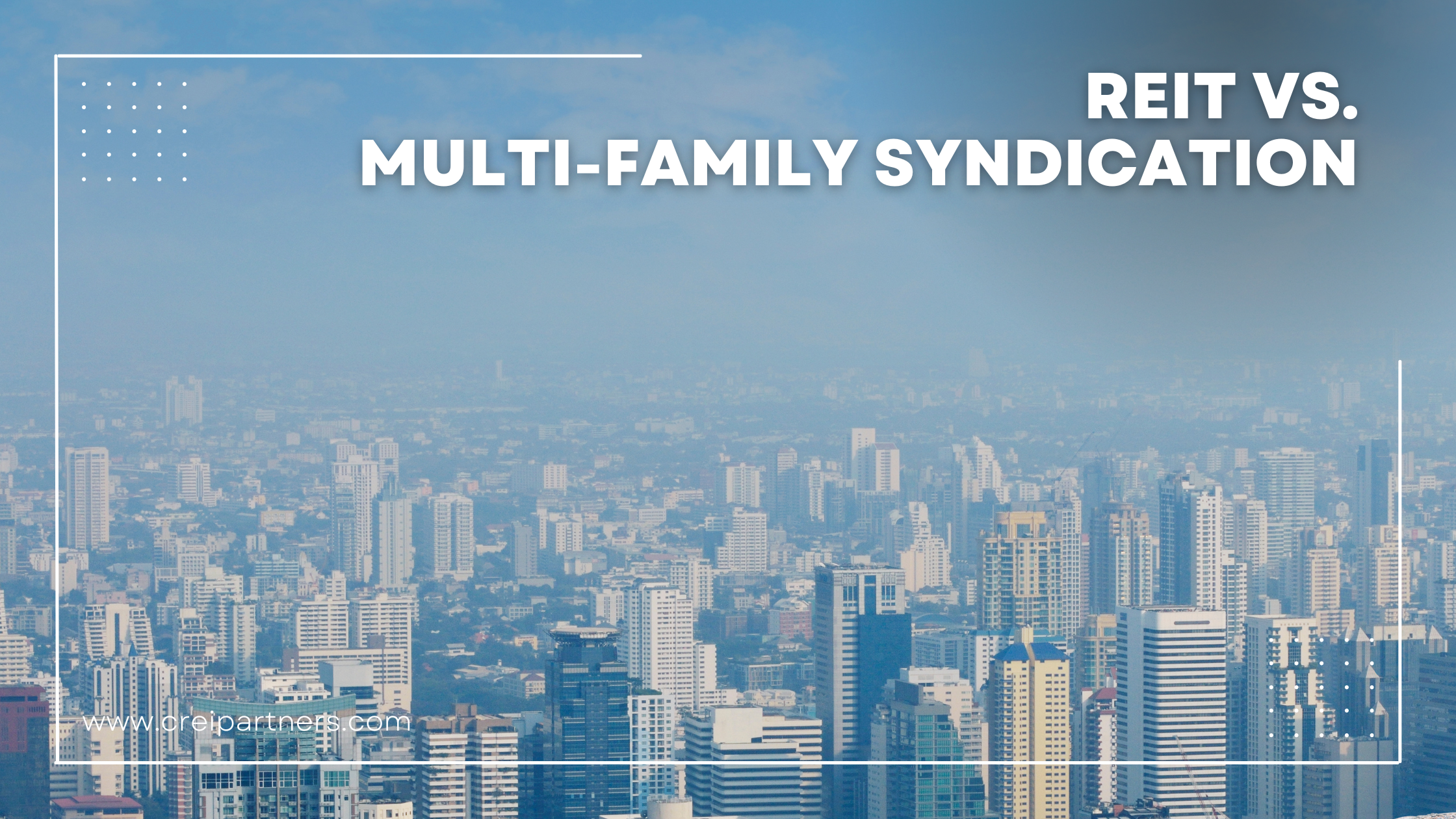REITs or Real Estate Investment Trusts and Multi-Family Syndications are both passive real estate investments. Each investment requires less time and risk than becoming a single-family home landlord. Both offer passive income by pooling resources with others. Both hands-off approaches gain higher returns compared to the stock market or other investment vehicles. However, there are some critical differences between the two opportunities. Let’s explore the differences between REITs and multi-family syndications.
What is a REIT?
A REIT or Real Estate Investment Trust is a company that owns and operates a group of income-producing properties. These may be apartment or office buildings, shopping malls, hotels, warehouses, or self-storage facilities or other property types. They may also invest in holding mortgages or loans. Investment in REITs is similar to buying stocks: shares are purchased through a brokerage account and can be liquidated at any time.
What is a Multi-Family Syndication?
A multi-family syndication is an investment opportunity in which a deal sponsor, such as CREI Partners, coordinates with a group of passive investors to buy, renovate, manage, and later sell an apartment complex or other commercial income-generating asset. Investors receive passive income during the holding period for the investment, and a share of equity once the property is sold.
What are the main differences between REITs and Multi-Family Syndications?
While REITs and multi-family syndications work toward a similar goal-leveraging a group of investors to capitalize on the opportunities available through commercial real estate investments-the particulars of each investment type can make one or the other a much better fit for any individual investor. There are major differences with respect to several topics:
- Number of Properties Involved
- Type of Ownership
- Access to Investment Opportunities
- Investment Minimums
- Liquidity of Funds
- Tax Benefits
- Anticipated Returns
Let’s dig in to how each type of investment differs on each topic.
Number of Properties Involved
A REIT is generally structured as a blind fund that supports investment into many properties. Most REITs will focus on a particular niche, such as apartment complexes, and own properties in many different local markets. Buying shares of a REIT contributes to the fund holding a multitude of properties, and the portfolio may fluctuate over time.
In contrast, a multi-family syndication deal is created for the express purpose of purchasing, managing, renovating, and selling a particular property. While evaluating the deal, you will know exactly which property is involved, where it is located, and what the business plan is for that particular asset. You can find out exactly what that property offers to investors through the sponsor’s market research and any you do personally. You can invest in multiple deals, but each syndication involves one particular property.
Type of Ownership
When buying shares of a REIT, you are investing in a company that owns a group of properties. This is similar to owning shares in any other company-you do not have ownership of what that company produces but, instead, have a small portion of ownership of that company.
When investing in a multi-family syndication, you are part of a group that directly owns the asset. This group includes the sponsor/general partners, and limited partner investors who all come together as the owners of the LLC or other entity that directly owns the property.
Access to Investment Opportunities
Most REITs are generally listed on major stock exchanges. This makes them easy to find and access, as they are publicly available. There are no particular requirements necessary to invest, just purchase shares through a brokerage, and that’s it.
Real estate syndications, on the other hand, are not always advertised publicly. SEC designated 506(b) offerings require a personal relationship to be established prior to the investment, and they cannot be publicly advertised. These are available to an unlimited number of accredited investors but only 35 sophisticated investors. There are also 506(c) offerings that can be advertised, but require that all investors be accredited. In general, networking is super important for finding and vetting syndication deals, and there may be a number of steps involved in the process.
Investment Minimums
REITs have no investment minimums. You can choose the amount you would like to spend on buying shares, and can proceed with even small investments. However, it is worth remembering that with a huge number of investors on an open market, there will be no personal attention from the REIT.
Multi-family syndications, however, often have a $50,000 minimum investment, though there can be some variability among deal sponsors. CREI Partners offers investments starting with a minimum of $50,000, and more can be invested as desired. With the differences in structure, as well as the limited number of investors and personal relationships built during the process, you can also be sure you will receive personal, periodic updates and can ask questions directly to the sponsor.
Liquidity of Funds
This is a huge differentiating factor between REITs and multi-family investment syndications. Shares of REITs can be bought and sold any time the market is open, offering the option of short-term or long-term investment. This also means that should you need the money for a different purpose, it can be accessed within a few days.
In multi-family syndications, the investment is not liquid and cannot be accessed until the property is sold. While there will be passive income during the holding period, this is generally a fraction of the amount of the initial investment. If the property is refinanced after renovation, there also may be a partial lump-sum return of the initial investment, but, in general, you must plan that the initial investment plus returns will not arrive for a period of 5-7 years on average.
Tax Benefits
As a partial owner of real estate in syndication, there are tax benefits that are not available when investing in REITs.
As an investor in a REIT, any dividends you receive are taxed as ordinary income. Dividends are ordinary income because you are investing in a company rather than directly in real estate. Depreciation of the asset is taken into account by the REIT before dividends are issued. Therefore, depreciation will not offset other income that is listed in your tax return.
On the other hand, there are more significant tax advantages when investing in multi-family syndications. As one of the property’s direct owners, you can claim depreciation of the asset-or loss in value over time. This depreciation can create a paper loss even while collecting passive income generated by the property. The loss in value from depreciation can be large enough to offset the passive income as well as some of the ordinary income listed in the tax return, lowering your total tax burden.
As always, consult with a tax expert to verify how this affects your personal tax situation.
Anticipated Returns
When talking about investment returns, it is always valuable to remember that actual returns can vary widely from anticipated returns. This depends on a variety of factors that may or may not be able to be controlled or predicted. Past performance does not guarantee future results.
REIT.com documents that REITs historically perform an average of 1%-4% better than the stock market average. REITs can be a dependable, stable source of dividends, averaging around 12% per year over the last 20 years. This means that for a $100,000 investment in REITs, the anticipated returns might be $12,000 per year.
On the other hand, sponsors of multi-family real estate syndications often set much higher goals. Many syndicators plan for a 2+ equity multiple or 20% average annual return over 5 years. This equates to doubling the investment after 5 years including both cash flow and profits from the sale. For example, a $100,000 investment into a multi-family syndication could double your money after 5 years, yielding a return of your initial investment plus another $100k in passive income and profits from the sale.
Conclusion: Are REITs or Multi-Family Syndications better for you?
As always, when evaluating investment opportunities that best fit your situation, the answer depends on you. Your personal goals and needs are the greatest factor that determines which real estate investment strategy works best for you.
If your goal is a set-and-forget long-term investment opportunity, multi-family syndications may be the best fit. A publicly traded REIT works better if you have limited funds to invest that you may need access to in the next few years. On the other hand, if your goal is to make use of depreciation to offset high income and yield a lower tax burden, then multi-family syndication is the way to go.
At CREI Partners, we are always happy to schedule a call to discover how we can help you meet your goals through multi-family syndications. Click “Invest with us” to start the process.
Additional REIT Resources:
Real Estate Investment Trusts (REITs) | Investor.gov
What is a REIT (Real Estate Investment Trust)? | REIT.com
Real Estate Investment Trust (REIT): How They Work and How to Invest (investopedia.com)


 Subscribe to our newsletter so you never miss out on new investment opportunities, podcasts, blogs, news and events.
Subscribe to our newsletter so you never miss out on new investment opportunities, podcasts, blogs, news and events.